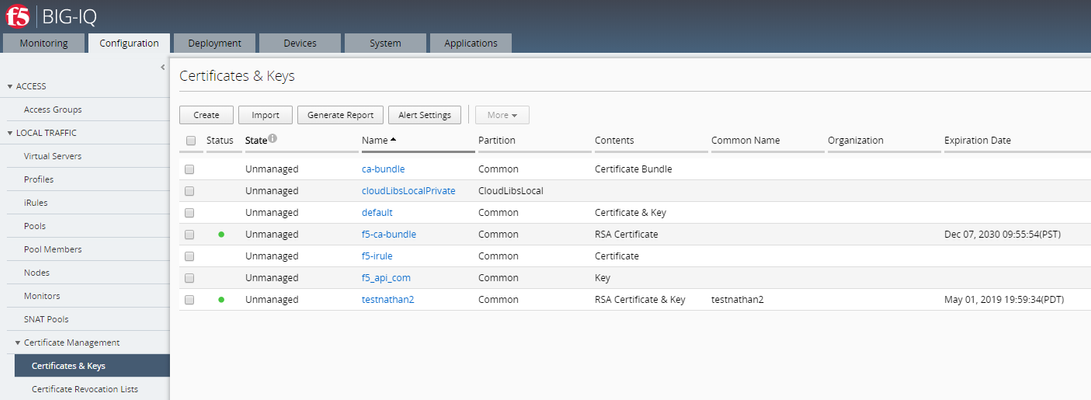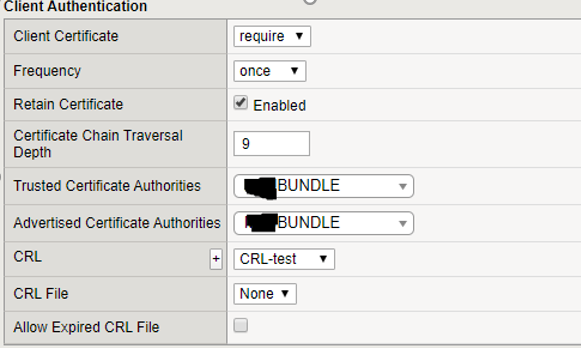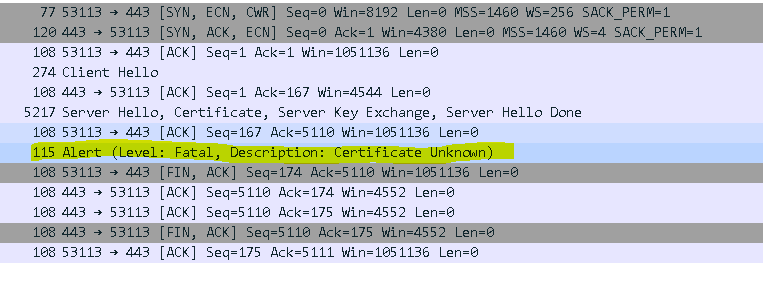certificate
88 TopicsAutomating ACMEv2 Certificate Management on BIG-IP
While we often associate and confuse Let's Encrypt with ACMEv2, the former is ultimately a consumer of the latter. The "Automated Certificate Management Environment" (ACME) protocol describes a system for automating the renewal of PKI certificates. The ACME protocol can be used with public services like Let's Encrypt, but also with internal certificate management services. In this article we explore the more generic support of ACME (version 2) on the F5 BIG-IP.14KViews12likes30CommentsAutomate import of SSL Certificate, Key & CRL from BIG-IP to BIG-IQ
The functionality to automate the import of SSL cert & key from BIG-IP to BIG-IQ is available in the product starting BIG-IQ 7.0 and above. This script should not be used on BIG-IQ 7.0+ as it has not been tested on those versions. This script will import all supported SSL Certificate, Key & CRL that exist as unmanaged objects on this BIG-IQ which can be found on the target BIG-IP. Steps performed by the script: Gather certificate and key metadata (including cache-path) from BIG-IPs Download certificate and key file data from BIG-IPs Upload certificate and key file data to BIG-IQ Prerequisite: Discover and import LTM services before using this script.The target BIG-IP will be accessed over ssh using the BIG-IP root account. Installation: The script must be installed in BIG-IQ under /shared/scripts: # mkdir /shared/scripts# chmod +x /shared/scripts/import-bigip-cert-key-crl.py Command example: # ./import-bigip-cert-key-crl.py <big-ip IP address> Enter the root user's password if prompted. Allowed command line options: -h show this help message and exit -l LOG_FILE, log to the given file name --log-level {debug,info,warning,error,critical}, set logging to the given level (default: info) -p PORT BIG-IP ssh port (default: 22) Result: Configuration > Certificate Management > Certificates & Keys Before running the script: After running the script: Location of the scripts on GitHub: https://github.com/f5devcentral/f5-big-iq-pm-team In case you BIG-IQ is running on Hardware: Step 1: Install packages using pip, targeting a location of your choice # mkdir py-modules# pip install --target py-modules requests argparse Step 2: Run using python2.7, adding py-modules to the python path # PYTHONPATH=py-modules python2.7 import-bigip-cert-key-crl.py <big-ip IP address>5.8KViews1like43CommentsTrouble applying GoDaddy certificate to a virtual server
I have created a few virtual servers and applied certs. They work just fine because they are using our internal CA. I have one now that uses a GoDaddy cert. I was provided a GoDaddy pfx file. I imported the cert and key without issues. I created the SSL profiles. In the CLientSSL profile, I chose the newly imported GoDaddy cert for Certificate, Key and Chain. I added the profile to the virtual server. When I open the virtual server in any browser, I get "The site can't be reached". Using FireFox, I get the error, "Error code: PR_CONNECT_RESET_ERROR". Because it's not an invalid cert error, I can't easily troubleshoot. Am I doing something that is glaringly wrong?Solved3.8KViews0likes18CommentsSupport dynamic CRL check for clientSSL profile (BIG-IP 15.1)
Hi, Did anyone tested (dynamic) CRL validator object for client SSL profile? (BIG-IP v15.1): It should work in v 15.1 (fixed bug 743758 - https://cdn.f5.com/product/bugtracker/ID743758.html ) I'm getting following errors for all client certificates: err tmm1[21207]: 01a40008:3: Unable to build certificate trust chain for profile /clientssl_profile tmm1[21207]: 01260009:4: clientIP:62042 -> VIP:443: Connection error: ssl_hs_do_crl_validation:6014: alert(46) unknown certificate error With CRL File it works ok, but file does not automatically fetch, check, and cache CRL files… Kr, EPX3.2KViews1like3CommentsImplementing SSL Orchestrator - Certificate Considerations
Introduction This article is part of a series on implementing BIG-IP SSL Orchestrator. It includes high availability and central management with BIG-IQ. Implementing SSL/TLS Decryption is not a trivial task. There are many factors to keep in mind and account for, from the network topology and insertion point, to SSL/TLS keyrings, certificates, ciphersuites and on and on. This article focuses on SSL certificates and everything you need to know about them. This article is divided into the following high level sections: Using OpenSSL Using Microsoft CA Importing a private key and certificate into SSL Orchestrator Manually Installing Certificates in browsers Creating a Certificate Signing Request (CSR) for Inbound Topology Using Group Policy Objects (GPO) to distribute certificates Please forgive me for using SSL and TLS interchangeably in this article. Software versions used in this article: BIG-IP Version: 14.1.2 SSL Orchestrator Version: 5.5 BIG-IQ Version: 7.0.1 Using OpenSSL OpenSSL can be used to sign a CSR. It can also be used to generate a self-signed certificate. When creating a CSR for production, you might need to use OpenSSL with a template in order to populate certain fields like the Digital Signature. This information is provided as a courtesy. OpenSSL contains an open-source implementation of the SSL and TLS protocols. The core library, written in the C programming language, implements basic cryptographic functions and provides various utility functions. Wrappers allowing the use of the OpenSSL library in a variety of computer languages are available. OpenSSL can be used to create private keys, certificates and more. Here’s an example of the syntax used to create a self-signed certificate: openssl req -x509 -sha256 -nodes -days 365 -newkey rsa:2048 -keyout privateKey.key -out certificate.crt Full instructions about how to use OpenSSL are beyond the scope of this article. However, the links below contain excellent information on usage: OpenSSL - Command Line Utilities SSLShopper- Common OpenSSL Commands Note: If you want to create your own OpenSSL Certificate Authority the following Dev/Central Article is excellent: Building an OpenSSL Certificate Authority - Creating Your Root Certificate Using Microsoft Certificate Authority This method is generally preferred to using self-signed certificates. Rather than reinvent the wheel, the Virtually There Blog does an excellent job of explaining the process to sign a CSR with a local Certificate Authority. Click the link below to learn more: VirtuallyThere - Signing a CSR with your Microsoft Certificate Authority Note: If you’re looking for information about how to setup your own local Microsoft CA see this previous blog: VirtuallyThere - Building a Microsoft Certificate Authority for your lab Note: the blog author has given f5 permission to include the links above. Installing signed certificate into SSL Orchestrator From the Configuration Utility > SSL Orchestrator > Certificate Management > Traffic Certificate Management. Click on the certificate created earlier (my_certificate). Click Import. Click Choose File and select the signed certificate from the CA. Click OK/Open. Click Import. Note: Using Certificate Chains or Subordinate CAs If using Certificate Chains be sure to include all intermediate certificates in the chain. For more information on Certificate Chains, see this Microsoft article. Import private key and certificate into SSL Orchestrator Follow the steps below if you already have the private key and certificate you want to use for SSL decryption. From the BIG-IP Configuration Utility click SSL Orchestrator > Certificate Management > Certificates and Keys. On the far right, click Import. For Import Type click Select. Different types of import options are available. For this example, select Key. Give it a name, in this example SSL.key. You can upload the key from a local file or paste it in as text. Choose the method you prefer and click Import when done. The example below shows the local file method. Click the name of the Key you created. Click Import. You can upload the certificate from a local file or paste it in as text. Choose the method you prefer and click Import when done. The example below shows the local file method. You have successfully imported the private key and certificate. Note: most Enterprise customers will have their own local Certificate Authority (CA). Creating a Certificate Signing Request (CSR) for Inbound Topology If you are creating an Inbound Topology you can use this method to create a CSR. From the F5 Configuration Utility go to SSL Orchestrator > Certificate Management > Certificates and Keys. Click Create on the top right. Give the certificate a name. For Issuer select Certificate Authority. Fill in the rest of the form. Click Finished when done. The page should look like the following. Click Download my_certificate to download it as a file. You can optionally copy the text output to the Clipboard. Download the CSR so it can be signed by your Local Certificate Authority. Manually Installing Certificates in browsers Certificates generated by SSL Orchestrator need to be trusted by the client computers. If using a Microsoft Certificate Authority (CA) to sign the SSL certificates the clients will trust it automatically, assuming they are members of the same domain as the CA. If using Self-Signed certificates you need to install them in the Certificate store on all client computers. Most Enterprise customers won't do this in production but it's often used for testing or demos. Either way, it's important to know these procedures. Firefox has its own Certificate store. Click the icon on the top right then Preferences. Note: Firefox version 70.0.1 was used in the configuration below. Scroll to the bottom of the next screen. Under Security click View Certificates. Click Import. Find the Certificate on your computer. Select it and click Open. Select the option to Trust this CA to identify websites. Click OK. Internet Explorer/Edge and Chrome use the Windows Certificate store. Locate the Certificate on your computer and double click it. Click Install Certificate. Click Next at the Import Wizard. Select the option to Place all certificates in the following store. Click Browse. Select Trusted Root Certification Authorities then OK. Click Next. Click Finish. You should see a Security Warning like the following. Click Yes. Click OK to the Successful Import message. Using GPO to distribute certificates Microsoft has a variety of support articles and documentation for how to do this with GPO: Distribute Certificates to Client Computers by using Group Policy Summary In this article we covered the most common tasks associated with SSL certificates and how to use them with SSL decryption. Next Steps The next article in this series will cover the Guided Configuration component of SSL Orchestrator.2.7KViews1like7CommentsDid Serverssl profile require certificate?
Hi We want to use F5 as SSL bridging (Decrypt using ssl client profile and re-encrypt using serverssl profile) Problem is our server using self-sign root certificate and certificate name is IP server (eg. 10.10.10.1 ) How do we config SSL server profile ? Should we just choose None on certificate setting? Should we import self-sign root certificate server using into BIG-IP? where to import? Thank you Kridsana1.6KViews0likes5CommentsSSL handshake failure during SSO
Both our production and non-production service desk applications use SSO. User connects to application VIP, which redirects users to the SSO VIP on 443. The F5 configuration for these two environments are identical: SSL bridging with default Client SSL profile as parent. No customizations except for the certificate/key/bundle. However in the non-prod environment, the SSL handshake cannot complete. tcpdump shows a fatal error, certificate unknown, even though this is the same cert/key on the SSO server. When I browse directly to the SSO VIP, the application works as expected. Currently the work-around is to have the non-prod ITSD application server bypass the F5 and go directly to the SSO app server rather than the F5.1.5KViews0likes11CommentsBIG-IQ & AS3 Template using Certificates uploaded to BIG-IQ
Good Day - Currently I am running BIG-IQ version 8.2.x, and we are deploying / migrating all legacy applications over to BIG-IQ AS3 templates. Currently we utilize a BYOC (Bring your own Certificate) model, where end users will need to download certs, copy and past into the applicaiton via BIG-IQ. I do not have the API process setup just yet, but they are bound by the AS3 template created in BIG-IQ. We are now looking at intergrating BIG-IQ with Venafi 22.4.1.2245. What I am trying to figure out is the following? My thought would be Venafi automated process to import/upload as in the link below into BIG-IQ, and then with the Veanfi intergration certificates could be set to auto renew, and the app owner would just need to republish their applicaiton to update certificate. https://clouddocs.f5.com/products/big-iq/mgmt-api/v0.0/HowToSamples/bigiq_public_api_wf/t_import_cert_and_key.html But now I am trying to how to link the AS3 templates for the applications to the certificate now imported into BIG-IQ. The values I have within the Certificate section of the AS3 template are the following: Base64 (We are not using this) Text (this what we are using for BYOC process where users copy and paste txt version of cert but looking to improve with the process above) Resource URL (I tried using similar for my cert like the below links from the above import article, but this is not working, for it is giving a pointer error) (Question? could this be a url to Venafi where it could download the certificate automatically?) https://localhost/mgmt/cm/adc-core/working-config/sys/file/ssl-key/ed0168ee-696f-3036-8266-7b81c4840246 https://localhost/mgmt/cm/adc-core/working-config/sys/file/ssl-cert/9c6dfe1c-7d89-3447-bf35-e58c88904a7c Copy from (I tried this with all different variants from the import document, but I just keep getting F5pointer error) Does anybody know how to use this to pull the certificate in? BIG-IP component pathname (This will not work as the cert would need to be pushed to the BIG-IP) Anybody have any thoughts on this? My goal is to not have to do any Certificate Management apsect, just either profile the link to where cert can be pulled from via BIG-IQ or Venafi when a user deploys the application. Ideally would be using the process to import the cert, and referencing this cert on BIG-IQ at deployment time? Any help would be greatly appreciated. Thx1.3KViews0likes3CommentsImporting RSA Certificate & key
Hi, I'm browsing SSL certificate list, and there are different types of Contents. I'm particularly in "RSA Certificate & key" since this is the method I'd like to import two of the newly received CA certificates. The problem is I have no idea how. I can easily import certificate and key in separate entries, but this seems to clutter the list. I'm also having difficulties in finding a proper instruction on the web. Please help or direct me to one, that just assumes me being a F5 first-timer :) thanks1.3KViews0likes2Comments




